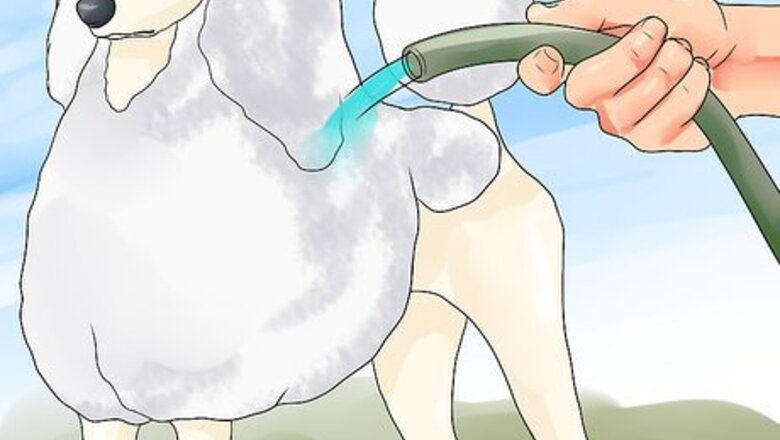
views
At the End of Bath Time
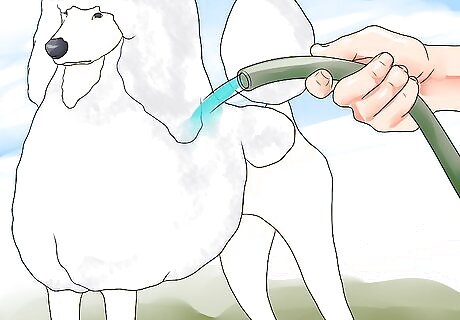
Rinse thoroughly. Use warm water to rinse out all traces of soap. If any shampoo remains in your dog's coat while you blow dry it, the soap can cause dryness and skin irritation. Make sure that the water is warm, not hot. Since poodle hair is so dense, it can take a long time for water to thoroughly saturate it. It is crucial that you do not rush the process and patiently make sure that all traces of shampoo are out of the coat before proceeding further. Avoid spraying the poodle's eyes with water and do not let any of the suds get into the dog's eyes, either. You may wish to protect the poodle's eyes by applying a thin coat of petroleum jelly or mineral oil around the outer perimeter of the eye. You may have to “knead” the poodle's coat as you rinse it to make sure that all traces of shampoo are scrubbed out.
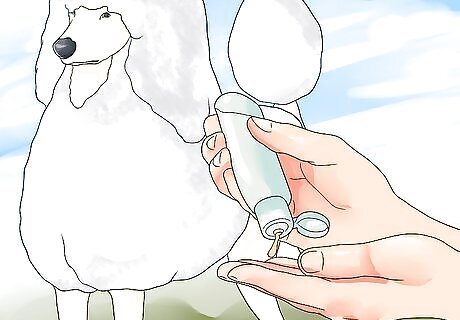
Consider applying a conditioner. After washing your poodle with water and dog shampoo, consider applying a dog conditioner to the coat. The conditioner will improve the health of your dog's coat and will make the blow drying process easier. Follow the instructions on the dog conditioner regarding proper application. Some conditioners should be left in, while others will need to be rinsed out. You could also opt for a detangler spray instead of a conditioner. Detangler will not offer the same overall health benefits for the poodle's coat, but it will still make combing and drying the coat easier.
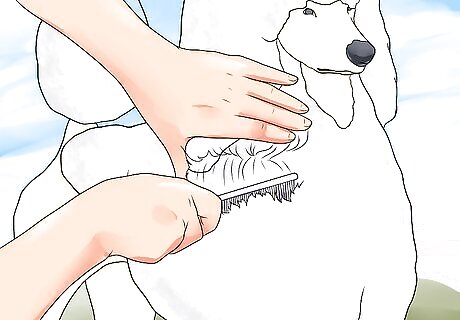
Comb out any knots. Gently brush your dog's wet coat with a slicker brush to remove any knots that developed during bath time. A slicker brush is a special type of brush that has thin metal wire tines poking up from a foam or rubber base. The design of the brush makes it easier to remove tangles and dead clumps of loose hair. Note that you could also use a large plastic comb during this stage. The comb will help you remove large knots but may not remove as many fine tangles as a slicker brush would.
Drying the Poodle
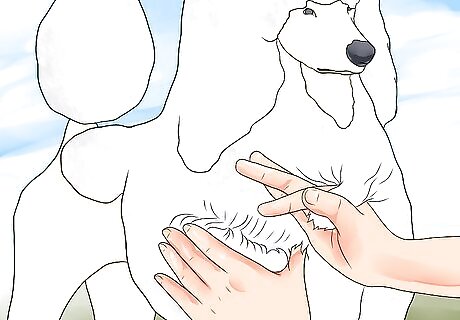
Squeeze out excess moisture. Wring out as much moisture as possible from the longest parts of your poodle's fur by gently squeezing the fur in between your hands. Focus on the tail and paws. Most of the water will accumulate in these areas, so most of the excess you need to remove during this step will be in these areas. Squeeze gently. Never pinch the dog's skin and avoid putting too much pressure on the dog's tails or legs. Also avoid pulling the hair as you wring it out.
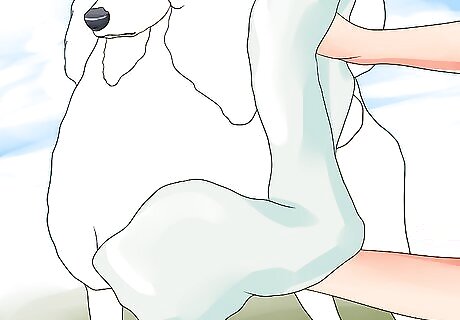
Towel dry the dog. Toss a soft towel over the dog. Rub and blot away as much moisture from the coat as possible using this towel. The towel should be large enough to cover the dog and made from an absorbent material, like terry cloth. Since poodles have a dense coat, you should work on blotting the water out rather than scrubbing it out. A lot of rubbing can cause the fur to become tangled, making it more difficult to comb out during the blow drying process. While towel drying the dog, check in its ears. Lightly dab away any noticeable moisture inside the poodle's ears. If you allow excess moisture to remain in a dog's ears, it can easily cause a painful infection.

Let your dog shake. If you have managed to prevent your dog from shaking and splattering water all over the place before this moment, now is the time for you to drop your guard and let your dog shake itself. Most dogs will want to shake their fur to remove excess water immediately after the bath, if not during it. Try to prevent your dog from doing so at those points to reduce the mess. Since shaking is so natural, though, it is recommended that you let your poodle shake after you have towel dried as much excess moisture as possible. Doing so will make the dog feel better, and it will also help your dog dry faster overall.
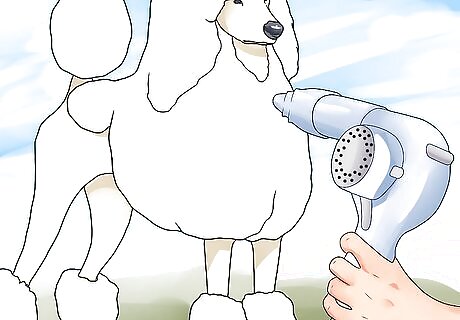
Blow dry the poodle using low heat. Set your blow dryer on the lowest heat setting possible and hold it a forearm's length away from the coat. Dry your poodle off with the blow dryer, maintaining this setting and distance the entire time. If possible, use a blow dryer specifically made for dogs and other pets. These machines are less likely to burn your dog than a human hair dryer is. A human blow dryer can still be used, if necessary, as long as it remains on a low to cool setting. It is better for your poodle to blow dry the coat rather than letting it air dry. Air drying will increase the number of mats and tangles that form. If you do choose to air dry your poodle, be aware of the fact that the hair will dry in curly ringlets. The only way to make the hair fluffy and straight is to dry the dog with a blow dryer.
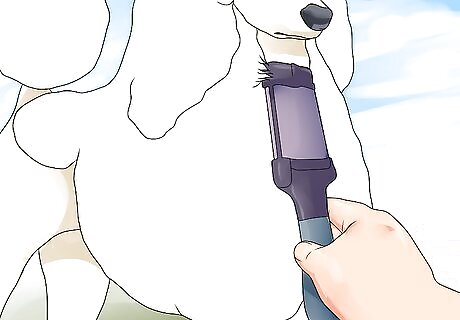
Brush out the coat as you dry it. As you blow dry the poodle's coat, you should simultaneously brush out any knots and mats with a slicker brush. If you do not brush and dry simultaneously, the coat will become more matted due to the force of the air blowing on it. These tangles will be more difficult to remove once the coat is dry than they will be to remove while the coat is in the process of drying. Brushing the poodle's coat as you dry it will also help the coat become softer and fluffier.
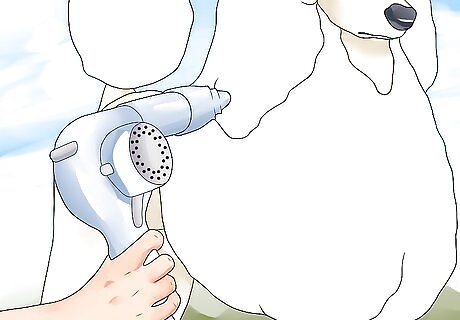
Work carefully. If you aren't careful, you could accidentally burn or hurt the poodle while drying its coat. As long as you pay attention as you work, however, the dog should be perfectly fine by the end of the process. Do not allow the blow dryer to come too close to the dog's skin, even if you have it set to a low heat. Your poodle's skin is too sensitive to heat, and even low dryer settings can cause the dog's skin to burn or otherwise become irritated. Never aim the blow dryer at the poodle's face. It is best to towel dry the hair on your dog's face, or to otherwise let it air dry. The skin of the face is especially sensitive to heat and prone to burning. If you use an automated dryer that hangs in front of a crated or leashed dog, you should test the temperature before aiming it at the poodle. You should also check the poodle every 5 to 10 minutes to make sure that the dog is still safe and not suffering from the heat.
Afterward
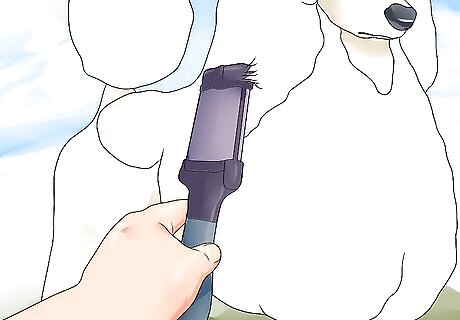
Brush out any remaining knots. After the poodle is completely dry, take a few minutes to brush out any knots you may have missed during the drying process. As before, use a slicker brush for best results.

Take care of the poodle's coat in between baths. Proper coat care will make both the bathing and drying process easier later on. The most important thing you need to do is simply to regularly brush the dog's coat. Brush your poodle at least twice a week, if not more frequently. Regular brushing will spread the natural oils produced by the skin throughout the coat, keeping it healthy. It also prevents tangles and mats, which can become painful for your dog if allowed to increase too severely. In between baths, brush your poodle with a natural bristle brush, especially on areas with longer hair. Use a slicker brush afterward to pull out any mats and dead hair. A comb can be run through the dog's hair after that to catch any additional tangles.












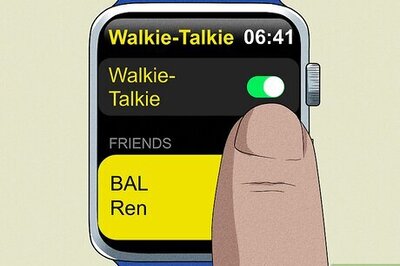
Comments
0 comment